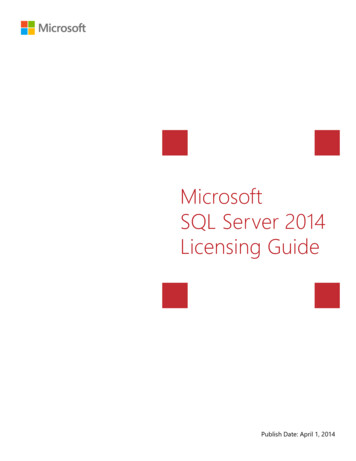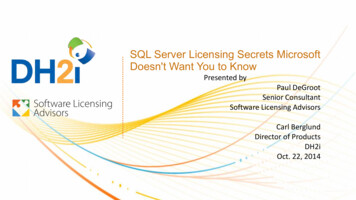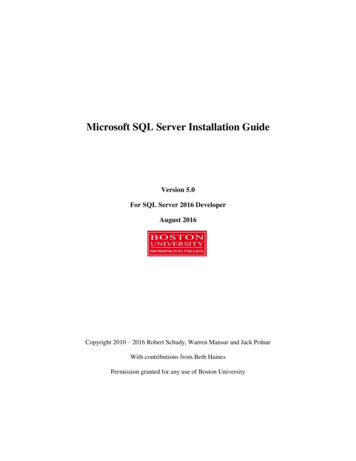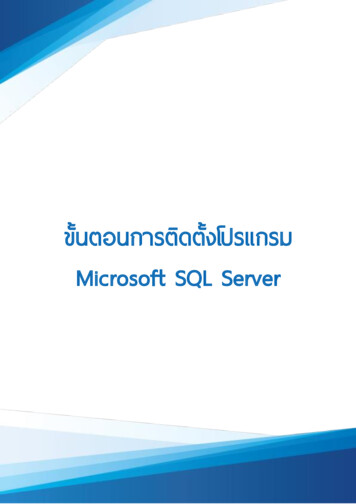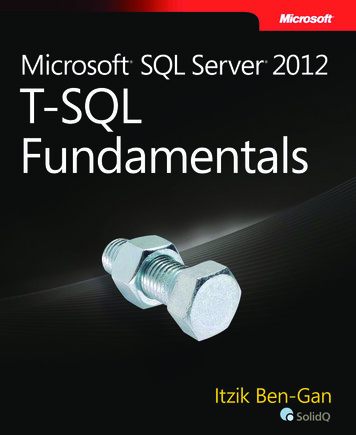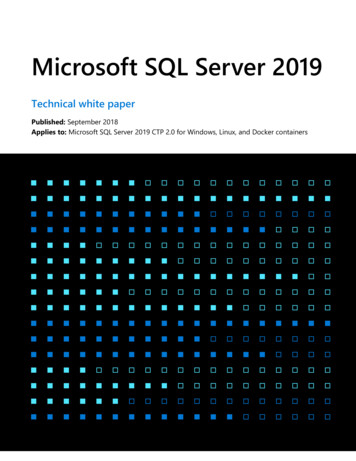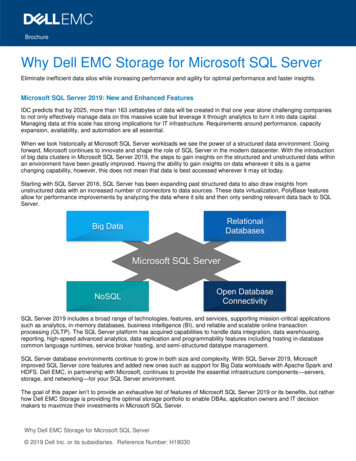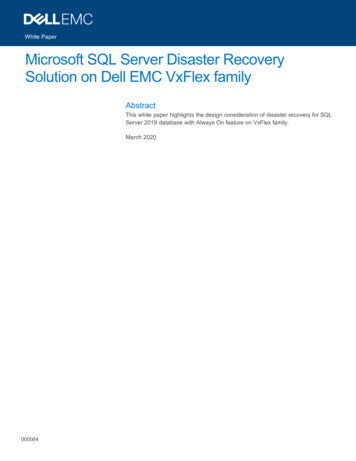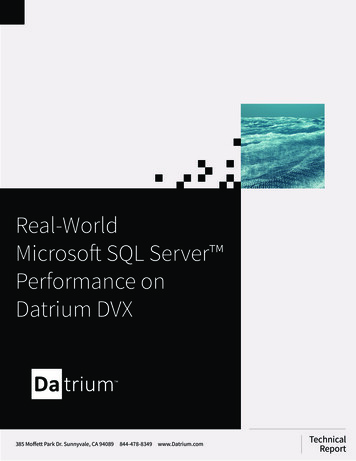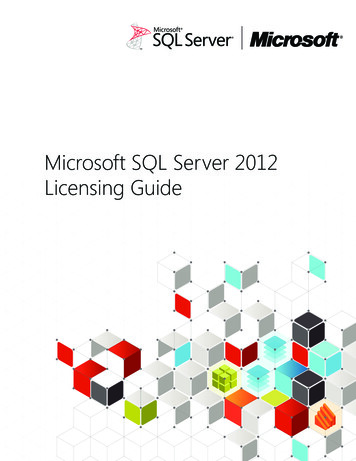
Transcription
Microsoft SQL Server 2012Licensing Guide
ContentsOverview.3SQL Server 2012 Editions.4How SQL Server 2012 Licenses Are Sold.5SQL Server 2012 Licensing Models.6Core-Based Licensing.7Server CAL Licensing.9Licensing SQL Server 2012 Components.10Licensing SQL Ser ver 2012 in a Virtualized Environment.10Licensing Individual Virtual Machines.11Licensing for Maximum Virtualization.12Licensing SQL Server 2012 Parallel Data Warehouse .13Advanced Licensing Scenarios and Detailed Examples.14Licensing SQL Server for High Availability.14Licensing SQL Ser ver for Non-production Use.16Licensing SQL Ser ver in a Multiplexed Application Environment.17Licensing SQL Ser ver for Application Mobility.18Additional Product Information.20Upgrades, Downgrades and Step-Ups.20SQL Server 2012 Migration Options for Software Assurance Customers.21Software Assurance Benefits.25Additional Product Licensing Resources.262
OverviewThis Licensing Guide is for people who want to gain a basic understanding of how Microsoft SQL Server 2012database software is licensed through Microsoft Volume Licensing programs. This guide does not supersede orreplace any of the legal documentation covering SQL Server 2012 use rights. Specific product license terms aredefined in the product Software License Terms—or in the case of Microsoft Volume Licensing—in the MicrosoftVolume Licensing agreement under which the software was acquired and/or the Microsoft Volume LicensingProduct Use Rights (PUR). This licensing guide is not a legal use rights document. Program specifications andbusiness rules are subject to change. 2013 Microsoft Corporation. All rights reserved.This document is for informational purposes only. MICROSOFT MAKES NO WARRANTIES, EXPRESS OR IMPLIED, IN THIS SUMMARY.Microsoft provides this material solely for informational and marketing purposes. Customers should refer to their agreements for a fullunderstanding of their rights and obligations under Microsoft’s Volume Licensing programs. Microsoft software is licensed not sold.The value and benefit gained through use of Microsoft software and services may vary by customer. Customers with questions aboutdifferences between this material and the agreements should contact their reseller or Microsoft account manager. Microsoft does notset final prices or payment terms for licenses acquired through resellers. Final prices and payment terms are determined by agreementbetween the customer and its reseller. Eligibility for Software Assurance benefits varies by offering and region and is subject to change.The Terms and Conditions of your Volume License Agreement and the Terms and Conditions under which any specific Software Assurancebenefits are offered will take precedence in the case of any conflict with the information provided here. For eligibility criteria and currentbenefit program rules, see the Microsoft Product List.3
SQL Server 2012 EditionsSQL Server 2012 is offered in three main editions to accommodate the unique feature, performance and pricerequirements of organizations and individuals: Enterprise Edition is ideal for mission critical applications and large scale data warehousing. Business Intelligence Edition, a new offering, provides premium corporate and self-service businessintelligence (BI). Standard Edition delivers basic database, reporting and analytics capabilities.The new editions are offered in a straightforward, tiered model that creates greater consistency across theproduct editions, features and licensing. The Enterprise Edition includes all the capabilities available in SQLServer 2012. The Business Intelligence Edition includes all Standard Edition capabilities, plus all BI capabilitiesincluded in the Enterprise Edition.SQL Server 2012 CapabilitiesSQL Server 2012 EditionsStandardBusiness IntelligenceEnterpriseCore-Based orServer CALServer CALCore-Based Basic High Availability Basic OLTP Basic Reporting & Analytics Programmability & Developer Tools(T-SQL, CLR, data types, FileTable) Manageability (Management Studio,Policy-Based Management) Enterprise Data Mgmt. (Data QualityServices, Master Data Services) Self-service Business Intelligence(Power View, PowerPivot for SPS) Corporate Business Intelligence(Semantic model, advanced analytics) Licensing OptionsWindows Server Core Edition SupportAdvanced Security (Advanced auditing,Transparent Data Encryption) Data Warehousing (ColumnStoreIndex, compression, partitioning) AlwaysOn High AvailabilityStreamInsight BasicBasicAdvancedThis table shows a comparison of key capabilities across the main SQL Server 2012 editionsWith the release of SQL Server 2012, the Workgroup and Small Business editions have been retired, and the WebEdition is now available only under a Microsoft Services Provider License Agreement (SPLA). The DatacenterEdition has also been retired, with all capabilities now available in SQL Server 2012 Enterprise Edition.Other specialty editions of SQL Server 2012 include Developer editions licensed for non-production use, thefreely downloadable and distributable Compact and Express editions, and the next generation SQL Server 2012Parallel Data Warehouse, which is available as an integrated appliance offering.ÂÂ For general information on each of the SQL Server 2012 editions, -2012-editions.aspx4
ÂÂ For more information on the new SQL Server 2012 Parallel Data Warehouse, utions-technologies/data-warehousing/pdw.aspxÂÂ For detailed product specifications and a full feature by feature comparison of the SQL Server 2012editions, visit: http://msdn.microsoft.com/en-us/library/ms143287(v sql.110).aspxSQL Server2012 EditionDatabase Engine (DBE) CapacityLimitsAnalysis Services (AS) and ReportingServices (RS) Capacity LimitsMaxComputeCapacityMax MemoryUtilizationDBEMax DBSizeMaxComputeCapacityMax MemoryUtilization ASMax MemoryUtilization RSEnterprisePer CoreOS MaxOS Max524 PBOS MaxOS MaxOS MaxEnterpriseServer CAL20 coreLimitOS Max524 PB20 core LimitOS MaxOS MaxBusinessIntelligenceLesser of 4sockets or16 cores64 GB524 PBOS MaxOS MaxOS MaxStandardLesser of 4sockets or16 cores64 GB524 PBLesser of 4sockets or 16cores64 GB64 GBWebLesser of 4sockets or16 cores64 GB524 PBLesser of 4sockets or 16coresN/A64 GBExpressLesser of 1socket or 4cores1 GB10 GBLessor of 1socket or 4coresN/A4 GB (AdvancedServices Edition)This table shows a comparison of the key capacity limits across the SQL Server 2012 editionsÂÂ For more information on the compute capacity limits for each edition of SQL Server 2012, 3760.aspxHow SQL Server 2012 Licenses Are SoldSQL Server 2012 software licenses are sold through channels designed to meet the unique needs of customers.These sales channels include online retailers offering full packaged product (FPP) licenses of SQL Server software,Original Equipment Manufacturers (OEMs) offering pre-installed licenses with their hardware systems, as wellas Large Account Resellers (LARs) and Enterprise Software Advisors (ESAs) offering SQL Server software throughMicrosoft Volume Licensing programs for end customer organizations.For customers with as few as five users, Microsoft offers licensing programs to help reduce administrativeoverhead and software management costs, while enabling product licensing on an ongoing basis at considerablediscounts. The various licensing options enable customers to choose the program that works best for theirmanagement and operational needs. Comprehensive programs that offer Software Assurance as a fixed benefit include the Open Value, OpenValue Subscription, Enterprise Agreement (EA), Enterprise Subscription Agreement (EAS) and the Enrollmentfor Application Platform (EAP). Transactional programs include Open, Select and Select Plus.Enrollment for Application PlatformThe EAP is a flexible cost-effective licensing program designed for EA customers who are standardizing on5
the Microsoft Application Platform. With the EAP, customers get the latest SQL Server and other ApplicationPlatform products across their organizations on new and existing deployments with lower up-front costs, andsavings of up to 40 percent on new IT solutions.Microsoft also offers programs that can meet the specific needs of organizations that partner with Microsoftto provide additional software and services, such as the Microsoft Independent Software Vendor (ISV) RoyaltyLicensing Program and the Microsoft Services Provider License Agreement (SPLA).SQL Server 2012 EditionRetail(FPP)Enterprise EditionVolume Licensing ProgramsOPEN SELECT EA/EAS/EAPThird PartyISVRSPLA Business Intelligence Edition Standard Edition Parallel Data Warehouse Edition Parallel Data Warehouse for Developers Developer Edition Web Edition Express EditionFree DownloadCompact EditionFree DownloadThis table shows the primary channel availability for SQL Server 2012 software licenses. Every edition may not be available in all channelsor licensing programs in all regions.ÂÂ For more information about Microsoft Volume Licensing Programs, download the Volume LicensingReference Guide 0853c1-a783-4d48-a7ad-f404abdb1e7d/Microsoft Volume Licensing Reference Guide.pdfÂÂ For details on the Microsoft Enrollment for Application Platform, -options/enrollments.aspx#tab 2SQL Server 2012 Licensing ModelsPrior to the release of SQL Server 2012, SQL Server 2008 R2 and earlier software versions were licensed throughMicrosoft Volume Licensing programs using one of two software licensing models: a Per Processor licensingmodel that reflected the computing power used and a Server plus Client Access License (Server CAL) licensingmodel, which is based on the users or devices accessing the product.With SQL Server 2012, Microsoft continues to offer customers a variety of licensing options aligned withhow customers typically purchase specific workloads. The Server CAL licensing model provides the option tolicense users and/or devices and then have low cost access to incremental SQL Server deployments. However,for customers who cannot count users or require premium database capabilities, the way Microsoft licensesSQL Server for computing power is changing. In the new computing-power based license model for SQL Server2012, the measure of computing power is shifting from physical processors to cores. Core-based licensing givescustomers a more precise measure of computing power and a more consistent licensing metric, regardless ofwhether solutions are deployed on physical servers on-premise, or in virtual or cloud environments.For details on licensing options for existing SQL Server Enterprise Edition customers licensed under theServer CAL model, refer to the Additional Product Information section of this guide.6
SQL Server2012 EditionsDescriptionLicensing OptionsServer CALEnterpriseHigh-end datacenter,data warehousing and BIcapabilitiesBusinessIntelligenceEnterprise BI and high scaleanalytics StandardBasic database and BIcapabilities Parallel DataWarehouseScale-out massively parallelprocessing (MPP) datawarehouse applianceCore-basedRequirements SQL Server CALs required SQL Server CALs required whenlicensing Server CAL This table compares the licensing options for each of the main SQL Server 2012 editionsCore-Based LicensingUnder the new Per Core licensing model, each server running SQL Server 2012 software or any of its components(such as Reporting Services or Integration Services) must be assigned an appropriate number of SQL Server2012 core licenses. The number of core licenses needed depends on whether customers are licensing thephysical server or individual virtual operating system environments (OSEs).Unlike the Server CAL licensing model, the Per Core model allows access for an unlimited number of users ordevices to connect from either inside or outside an organization’s firewall. With the Per Core model, customersdo not need to purchase additional client access licenses (CALs) to access the SQL Server software.Physical ProcessorsPhysical ServerPhysical CoresThis figure depicts a physical server with two physical processors, each containing six physical coresPhysical ServerA server is a physical hardware system capable of running server software. Ahardware partition or blade is considered to be a separate physical hardware system.Physical ProcessorA processor is generally a physical chip that resides in a physical socket of thehardware partition and contains one or more cores.Physical CoreEach physical processor contains smaller processing units called physical cores.Some processors have two cores, some four, some six or eight, and so on. The figureabove shows an example of two physical processors with six cores each.Hardware ThreadA hardware thread is either a physical core or a hyper-thread in a physicalprocessor.Physical OperatingA physical operating system environment (OSE) is configured to run directly on aSystem Environment physical hardware system and is all or part of an operating system instance.For detailed definitions of these and other key licensing terms, please refer to the Microsoft Volume Licensing PUR7
How to License SQL Server 2012 Using the Per Core Licensing ModelWhen running SQL Server in a physical OSE, all physical cores on the server must be licensed. Softwarepartitioning does not reduce the number of core licenses required, except when licensing individual virtualmachines (VMs). The minimum number of licenses required for each processor on the server still applies.To determine and acquire the correct number of core licenses needed, customers must:1. Count the total number of physical cores in the server.2. Multiply the number of cores by the appropriate core factor to determine the total number of licensesrequired for the server.Note: The core factor used depends on the processor type deployed, and a minimum of four core licensesis required for each physical processor on a physical server.Purchase the appropriate number of core licenses required for the server. Core licenses are sold in packs oftwo, so customers must divide the number of licenses required by two to determine the actual number of lineitems (licensing SKUs) to order.Number of core licenses required:2 Intel Xeon 6-core processors12x1 12(total cores on the server)(core factor from the table below)core licenses requiredPurchase 6 “2-Pack” SKUs of core licenses(cores sold in 2-core packs)SQL Server Core Factor Table*SQL Server Core Factor Table*Processor TypeProcessor TypeAll processors not mentioned belowAll processors not mentioned belowAMD Processors 31XX, 32XX, 41XX, 42XX, 61XX, 62XX Series Processors with 6 or more coresAMD Processors 31XX, 32XX, 41XX, 42XX, 61XX, 62XX Series Processors with 6 orSingle-Coremorecores ProcessorsCore FactorCore Factor110.750.754Dual-Core ProcessorsSingle-CoreProcessors4 2Dual-Core Processors2*This is an example of the core factor table and how it is used to calculate core license requirements. Core factors are subject to change,and customers can find the most recent version of the core factor table at the link below.ÂÂ For more details on the Per Core licensing model, including keys terms and licensing definitions,download the Introduction to Per Core Licensing Volume Licensing Brief: /briefs/licensing-by-cores.aspxÂÂ For more information on the SQL Server 2012 Core Factor Table, including how to determine anduse the appropriate core factor when licensing SQL Server 2012 under the Per Core model, visit:http://go.microsoft.com/fwlink/?LinkID 229882The Per Core licensing model is appropriate when: Deploying the SQL Server 2012 Enterprise or Parallel Data Warehouse editions. Deploying Internet or extranet workloads, systems that integrate with external-facing workloads (even ifexternal data goes through one or more other systems), or when the number of users/devices cannot becounted easily. Implementing centralized deployments that span a large number of direct and/or indirect users/devices.8
The total licensing costs are lower than those incurred using the Server CAL licensing model.Note: The use of hyper-threading technology does not affect the number of core licenses required whenrunning SQL Server software in a physical OSE.For details on how to license virtual OSEs using the Per Core model, refer to the Licensing SQL Server 2012 forVirtual Environments section of this guide.Server CAL LicensingWhen licensing SQL Server software under the Server CAL model, customers purchase a server license foreach server and a client access license (CAL) for each device (Device CAL) and/or user (User CAL) accessing SQLServer or any of its components. A CAL is not software; it is a license granting users and devices access to theSQL Server software.Server LicenseLicenses the server on which SQLServer software or any of itscomponents is runningDevice CALLicenses a device accessing or usingthe services or functionality of SQLServer or any of its componentsORUser CALLicenses a person accessing or usingthe services or functionality of SQLServer or any of its componentsThis figure illustrates the licen
as Large Account Resellers (LARs) and Enterprise Software Advisors (ESAs) offering SQL Server software through Microsoft Volume Licensing programs for end customer organizations. For customers with as few as five users, Microsoft offers licensing programs to help reduce administrative o

